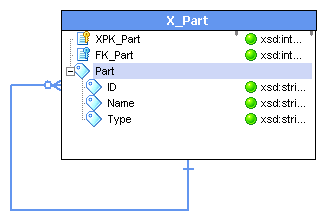PowerCenter
- PowerCenter 10.4.0
- All Products

<xs:element name="Part"> <xs:complexType> <xs:sequence> <xs:element name="ID" type="xs:string"/> <xs:element name="Name" type="xs:string"/> <xs:element name="Type" type="xs:string"/> <xs:elementref="Part"minOccurs="0" maxOccurs="unbounded"/> /xs:sequence> </xs:complexType> </xs:element>

<Part><ID>1</ID><Name>Big Part</Name> <Type>L</Type><Part><ID>1.A</ID><Name>Middle Part</Name> <Type>M</Type><Part><ID>1.A.B</ID><Name>Small Part</Name> <Type>S</Type> </Part> </Part> </Part>
